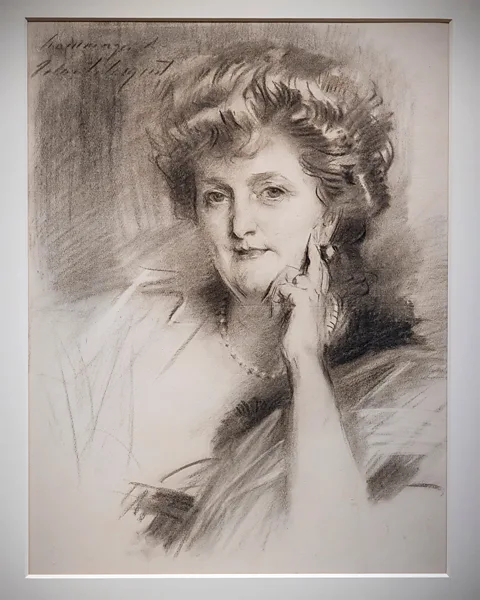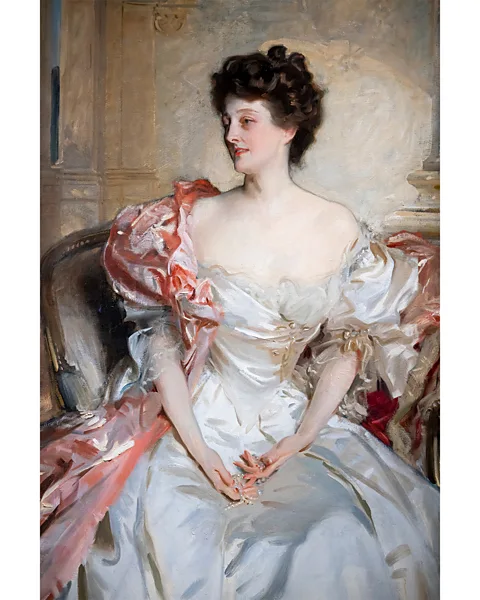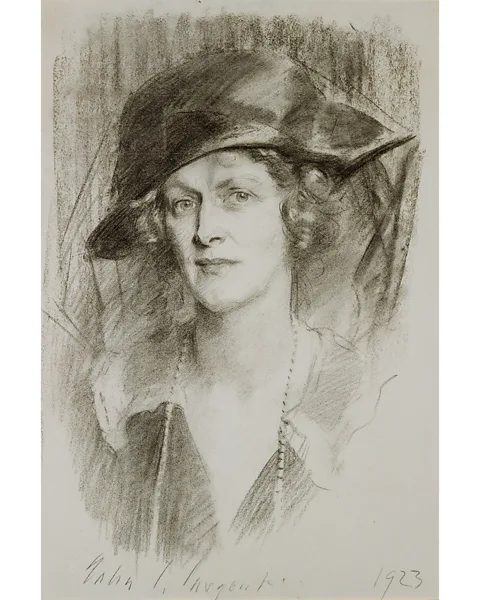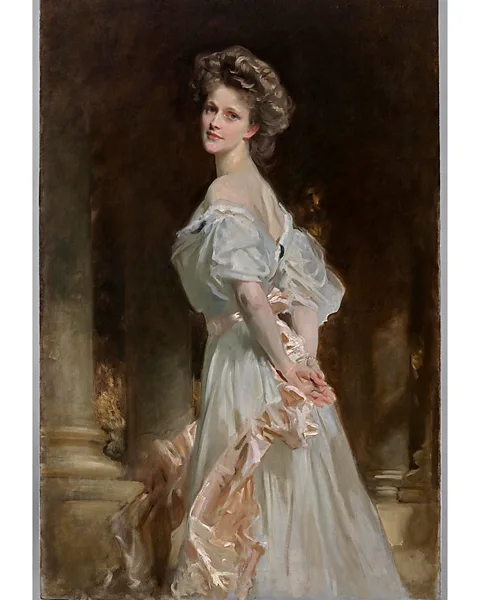'There was a real gutsiness about them': How the heiresses dubbed the 'dollar princesses' brought US flair to the UK
 National Trust Images, Matthew Hollow
National Trust Images, Matthew HollowThe rich, glamorous, American women of the gilded age who married into the English aristocracy faced some challenges – but they were resilient, formidable characters. As TV's The Buccaneers season two begins, and an exhibition in London is devoted to them, we explore the lives of the women who inspired writers and artists.
Can the new Duchess of Tintagel steer clear of scandal? Will her fugitive sister, Jinny, keep her baby from the clutches of her husband, the monstrous Lord Seadown? Can Mabel and Honoria's forbidden love flourish?
 Apple TV+
Apple TV+The Buccaneers, Apple TV+'s hit period drama, is back for a second season, and its legions of fans expect answers to all of the above. The show charts the romantic adventures of a group of young American women – two pairs of sisters and their friend – who, looked down upon as nouveau riche by older, grander New York families, come to England in the 1870s and cut a swathe through high society. Fast-moving, fun and visually sumptuous, it looks as though the costume budget alone could dwarf the entire expenditure of lesser shows. It is lavish, colourful escapism – yet the unfinished Edith Wharton novel of 1938 upon which it is based was inspired by a real phenomenon.
Between 1870 and 1914, 102 American women – 50 of them from New York – married British peers or the younger sons of peers, and many more married into the upper classes. They were dubbed "dollar princesses" and the popular view was that these were purely transactional marriages – cash for class. The women gained a title and status; the often cash-strapped aristocrats got a welcome injection of money to help them fix the leaking roof of the crumbling family seat.
 English Heritage
English Heritage"The decline in landed income during the Great Agricultural Depression, beginning in the 1870s, necessitated numerous male aristocrats to seek marital alliances outside the inner social network of the British aristocracy," explains Maureen Montgomery, a historian and Wharton scholar who is currently editing The Buccaneers for the Oxford University Press's The Complete Works of Edith Wharton.
"Another factor was the openness of the Prince of Wales, later King Edward VII, to wealthy businessmen being part of his inner social circle and his penchant for the beautiful and entertaining daughters of the American bourgeois elite who were travelling in ever larger numbers, after the Civil War, to Europe."
The first inklings of a novel to be called The Buccaneers appear in Wharton's notebook for 1924-1928. There she set out the plot, revolving around the "conquest of England by American adventurers & adventuresses/families".
"In the summer of 1928, during one of her many annual trips to England in her later years, she visited Tintagel in Cornwall and stayed with her close friend Lady Wemyss at her Cotswold estate, Stanway," Montgomery tells the BBC. "Both of these places became significant settings for the novel."
 English Heritage
English HeritageHowever, Montgomery doesn't believe that there is any one particular story or person that the writer drew upon.
"Wharton had close friends among the British aristocracy, and went to weekend country house parties. She personally knew a number of titled Americans. She would have been familiar with various scenarios for these marriages, how they were received, the different motives for marrying," she says.
Some historians have suggested Consuelo Vanderbilt as one of the possible models for The Buccaneers' Conchita Closson. Considered a great beauty, Consuelo was a "dollar princess" whose father made a fortune in railroads. Her dowry was worth tens of millions in today's money. She was more or less bullied by her mother into marrying Charles Spencer-Churchill, 9th Duke of Marlborough, and was said to have wept behind her veil at the altar on her wedding day in 1895 (one of nine US heiresses to marry English aristocrats that year).
More like this:
• The true story of the first ever 'rock star' chef
The marriage was deeply unhappy. "Sunny", as the Duke was known, wasted little time in telling her he'd only married her for her money and in order to save Blenheim Palace, the ducal seat. In her memoir, The Glitter and the Gold, Conseulo wrote of a Blenheim Palace butler who had drowned himself: "As one gloomy day succeeded another I began to feel a deep sympathy for him." Her marriage produced two children but both Consuelo and her husband had lovers.
 National Portrait Gallery, London
National Portrait Gallery, LondonConsuelo had been preceded into the aristocracy by the godmother after whom she was named. The Cuban-American heiress Consuelo Yznaga Montagu, another model for Conchita, married George Montagu, Viscount Mandeville, in 1876 and became the Duchess of Manchester when he inherited the title. The profligate duke burned through his wife's money and had numerous affairs. Consuelo, who is mentioned in Wharton's notebook, was reportedly very close to the Prince of Wales.
'Swashbuckling beauties'
Both Consuelos feature in Heiress: Sargent's American Portraits, an exhibition of 18 works by John Singer Sargent at Kenwood House on London's Hampstead Heath. The show has been curated by Wendy Monkhouse, English Heritage Senior Curator (South), and is the result of two years' work.
"There was a real gutsiness about these heiresses," Monkhouse tells the BBC. "They were brave. They had a hard time entering British society as foreigners, and foreigners of whom everybody was envious and resentful and wanted to take down a peg or two because of this 'buccaneer' trope."
 English Heritage
English HeritageThey were, supposedly, swashbuckling beauties who leapt aboard the good ship Britannia and, with piratical ruthlessness, bagged themselves a baron or an earl or maybe even a duke. The English newspaper editor WT Stead used the expression "gilded prostitution" when writing about these transatlantic marriages.
There was opposition from the US too, at the highest level. President Theodore Roosevelt wrote to his ambassador to the UK Whitelaw Reid in 1906, "I thoroly [sic]… dislike these international marriages… which are based upon the sale of the girl for her money and the purchase of the man for his title." And plenty of ordinary Americans hated the idea of all that wealth leaving the country and being squandered on wastrel British aristocrats. This wasn't what they'd fought a war of independence for.
But Monkhouse argues that the moniker "dollar princesses" does the women a disservice. "I think it's a term that has been tossed around for a hundred years without very much thought, apart from in academic circles," she says. "The more that you delve into it, the more it falls apart. I think Consuelo Vanderbilt, though she doesn't call herself a dollar princess, sort of defined the genre in that she was a very rich American who was, not by her own choice, married for a title and then was unhappy."
However, other women whose images are featured in the exhibition had very different stories. Daisy Leiter, glamorous and independent-minded daughter of a Chicago real estate magnate, was considered quite the catch and not just for her money, as Sargent's magnificent portrait shows. She was bombarded with proposals but married Henry Howard, the 19th Earl of Suffolk. It seems to have been a very happy love match and produced three sons. In later life, Daisy further exemplified the adventurous spirit of many of these women by becoming a helicopter pilot.
 English Heritage
English HeritageAnother of Sargent's subjects was Cora, Countess of Strafford. Her name is echoed by that of a famous fictional "dollar princess", Cora, Countess of Grantham, in Downton Abbey. Julian Fellowes has said that one of the inspirations for the series was a book about American heiresses called To Marry an English Lord. The real Cora was a Southern belle who married the 4th Earl of Strafford after the death of her first husband, toothpaste baron Samuel Colgate. The Earl died just five months after the wedding when he fell on to railway tracks at Potter's Bar. The incident prompted much gossip, as did the fact that Cora wore her coronet sideways at Edward VII's coronation.
One of the best known of the women in the Heiress exhibition, represented in both an oil portrait and a charcoal drawing, is Nancy Astor, Viscountess Astor, the daughter of a Virginian railway tycoon and the first woman to take her seat as an MP in the House of Commons. She had regular clashes with Winston Churchill, whose own mother, Jennie Jerome, was the daughter of a wealthy New York speculator and financier.
There's a splash of politics in the new season of The Buccaneers that sees Nan realising that her elevated social status gives her power and influence, and beginning to wield it. Buccaneers showrunner Katherine Jakeways read extensively on the "dollar princesses" before writing began on the series, and she draws on their stories, as well as the Wharton text.
"You imagine that the girls who came over were interesting to the men because (a) they were beautiful, (b) they were American and (c) they were rich, but actually what's really interesting is that (d) they were much better educated and much more encouraged to be confidently involved in society [than their English counterparts]," she tells the BBC. "In New York their opinions were sought whereas girls in England, as we show with Honoria in Season one, were asked not to speak or have an opinion."
 National Trust Images/ Matthew Hollow
National Trust Images/ Matthew HollowLike their real-life counterparts, the women in the show don't conform to reductive stereotypes. "Our characters are complicated and have depth, and we try to make all the relationships have some kind of resonance for a contemporary audience," says Jakeways. "And hopefully it's just really good fun."
Season two is another rollercoaster ride that remixes all the successful ingredients from the first series. Will there be a season three? I'd bet an heiress's dowry on it.
The Buccaneers Season Two premieres on Apple TV+ on 18 June.
Heiress: Sargent's American Portraits is at Kenwood House, London, until 5 October.
--
If you liked this story, sign up for The Essential List newsletter – a handpicked selection of features, videos and can't-miss news, delivered to your inbox twice a week.
